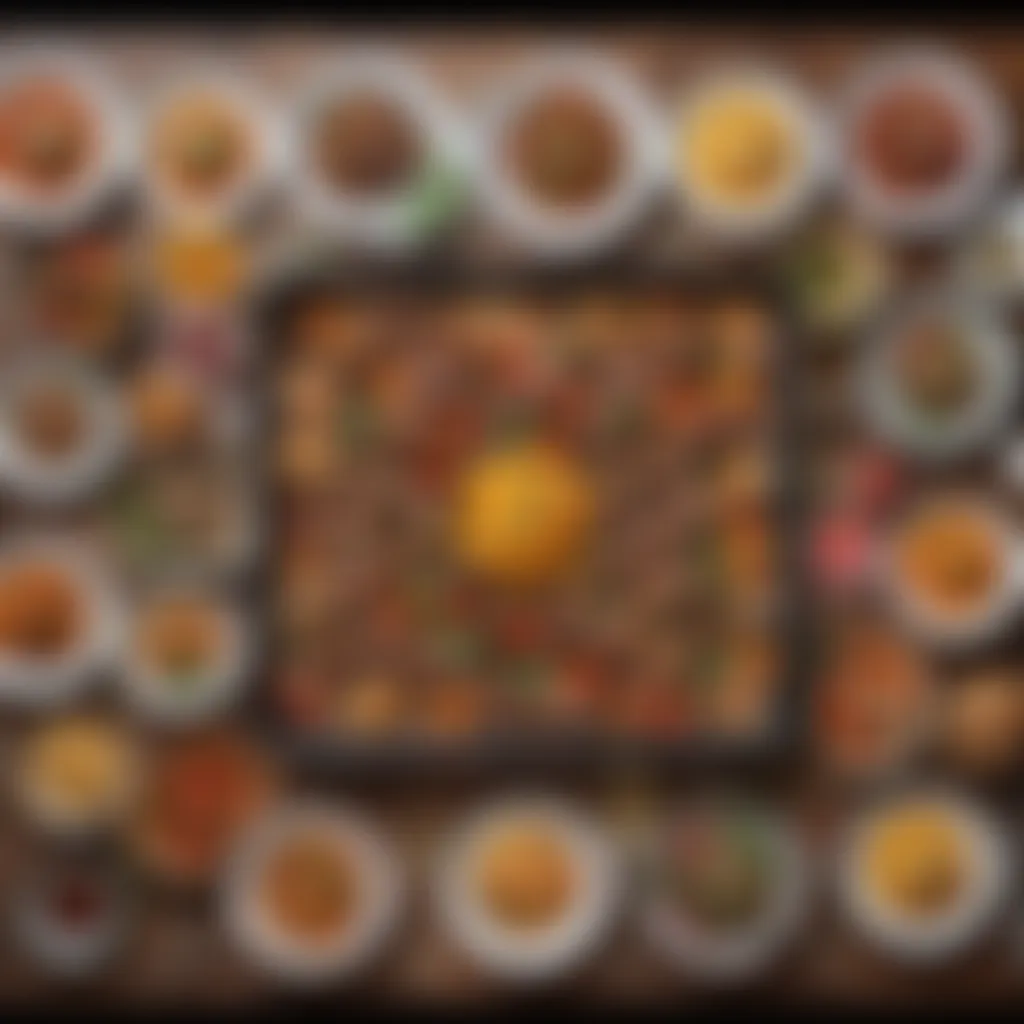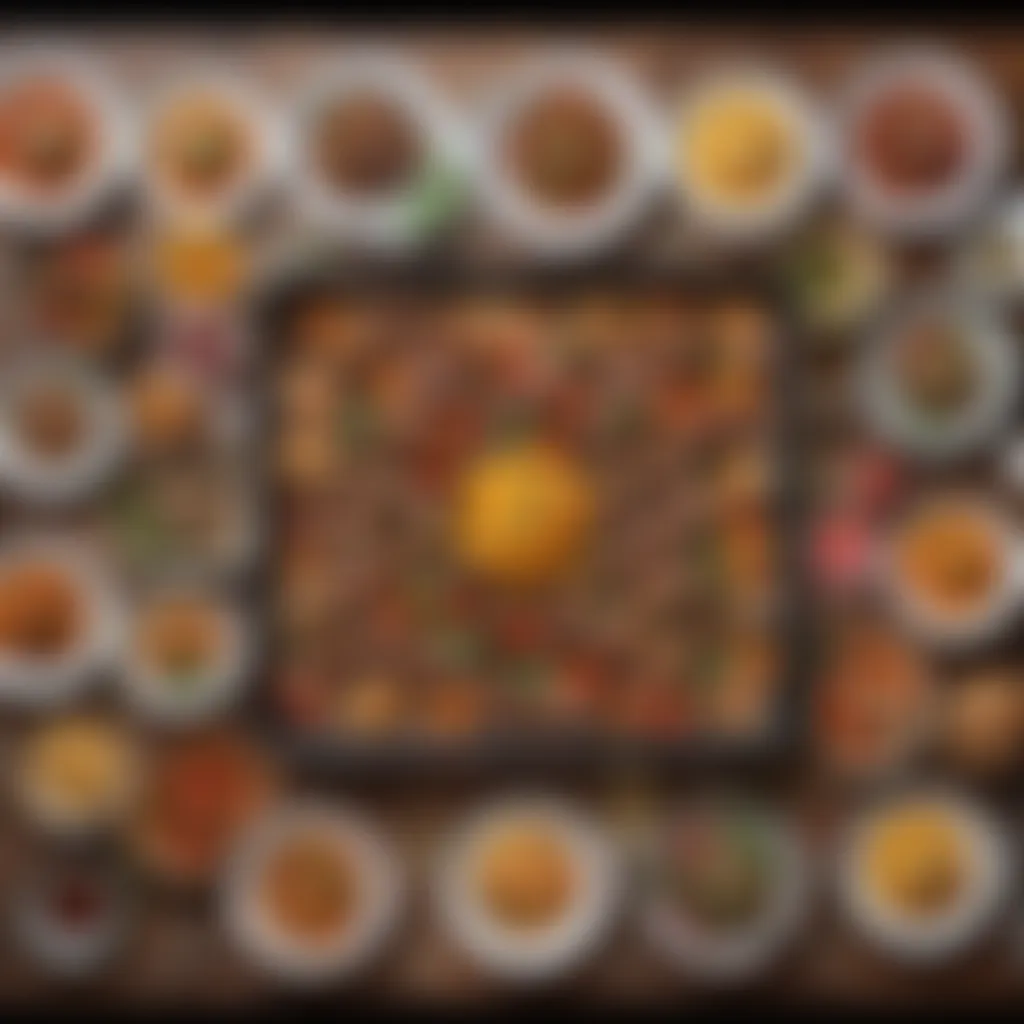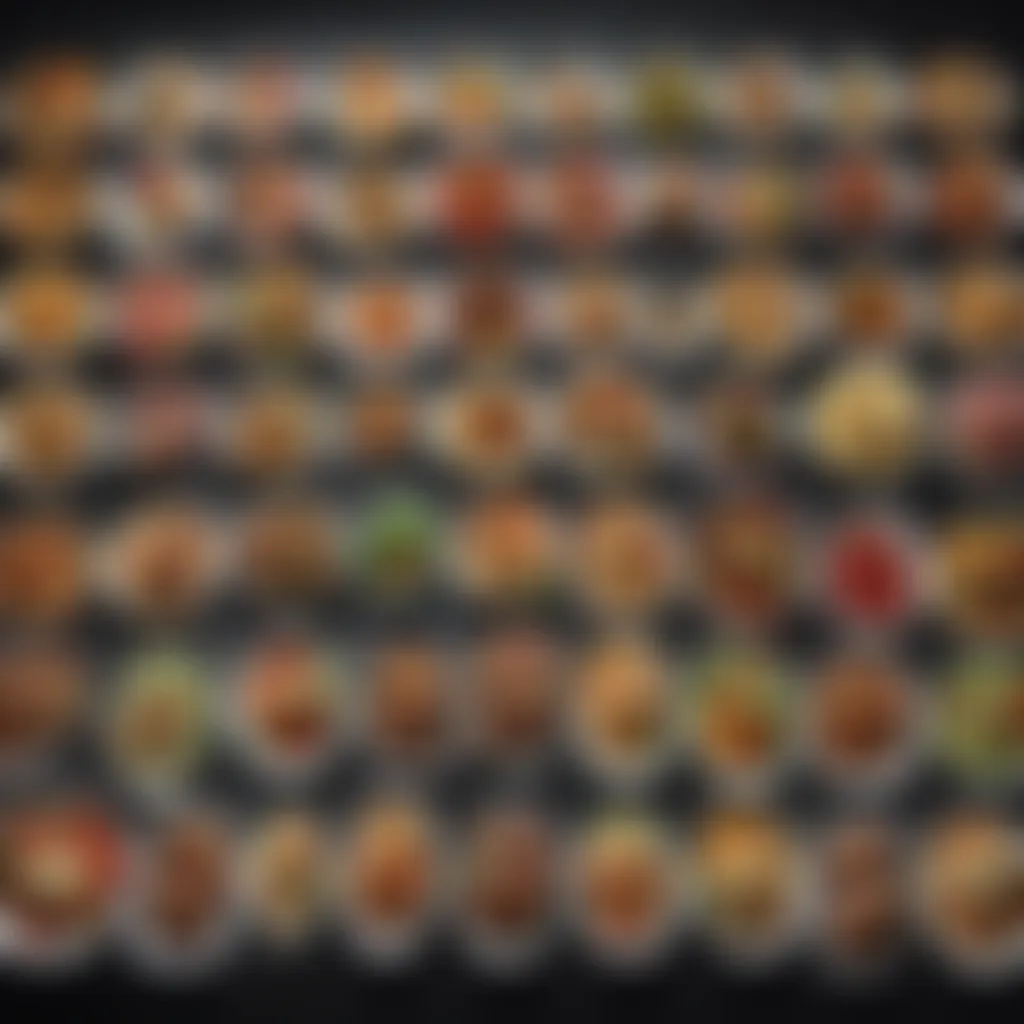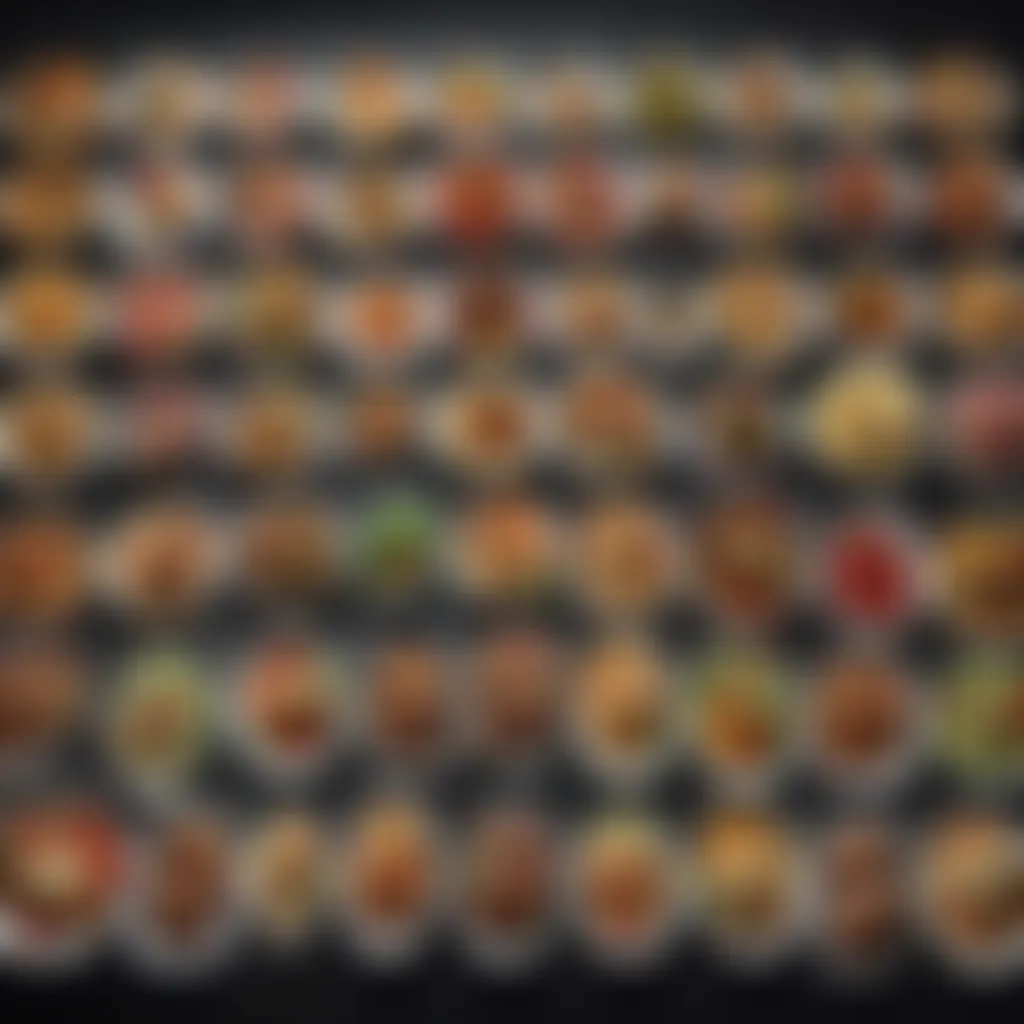1200-Calorie Meal Planning: Balanced Recipes & Strategies


Intro
When it comes to meal planning, striking the right balance within a limited caloric framework can seem daunting. However, with thoughtful preparation and understanding of nutritional needs, achieving a 1200-calorie diet can not only be feasible but also enjoyable. This guide outlines the essentials of crafting balanced recipes that not only stay within the calorie limit but also provide the nutrients necessary for a healthy lifestyle.
Understanding the key components of a well-planned meal is vital. It’s about more than just counting calories; it’s about nourishing your body effectively while keeping meals pleasing to the palate. Choosing the right combinations of proteins, fats, and carbohydrates can ensure that your meals are satisfying, without leaving you feeling deprived.
From fresh ingredients to straightforward cooking methods, this article will delve into what you need to kick off your 1200-calorie meal planning journey. By the end of this guide, you’ll have a wealth of recipes at your fingertips, along with practical tips to help you succeed in your culinary endeavors. So let’s roll up our sleeves and get started on this flavorful journey.
Understanding Calories
Understanding the concept of a 1200-calorie diet can be a game changer for individuals aiming to manage their weight and improve their overall health. Many people find it quite daunting to navigate caloric restrictions while ensuring that they consume meals that are not only filling but also nutritionally substantial. So, why focus on 1200 calories? This caloric limit serves as a good benchmark for those who want to shed a few pounds or simply need to rethink what goes onto their plates.
The main aim here is to derive maximum benefit from every calorie consumed. The idea is simple: when caloric intake is decreased, the body will start to use stored fats for energy, effectively aiding weight loss. However, this does not mean a person is left hungry or deprived. The secret lies in meal planning and making sure that each component on your plate carries a punch of nutrition.
Moreover, understanding 1200 calories helps in maintaining a balanced dietary approach, one that takes into consideration the essential nutrients required by the body. There’s more to it than just cutting back on food. Knowledge about how to portion meals correctly, incorporate diverse food groups, and choose nutrient-dense options is crucial.
"A diet low in calories doesn't mean a diet low in satisfaction; it’s about smart choices."
The Purpose of a 1200-Calorie Diet
The purpose behind adhering to a 1200-calorie diet goes beyond simple appetite control. Essentially, it encourages the consumer to be more mindful of the choices they make regarding food. This diet typically emphasizes whole foods like vegetables, fruits, lean proteins, and whole grains. The goal is to optimize nutrition within a calorie ceiling, promoting not just weight loss but a potential shift in long-term eating habits.
When the focus is shifted to consuming lower-calorie but nutrient-rich foods, individuals are often surprised to discover that they aren’t sacrificing variety. Plenty of flavors can be packed within meals if you know where to look. It’s about sociable, enjoyable eating that also keeps health at the forefront.
For instance, instead of focusing solely on ‘how many calories’ are in a meal, consider ‘what nutrients’ those calories provide. This proactive mindset can help to stave off cravings and create a healthier relationship with food.
Who Should Consider This Diet
Individuals considering a 1200-calorie diet usually do so for different reasons. Those with a more sedentary lifestyle may find this type of meal plan beneficial to reduce body mass while still ensuring they maintain energy levels. Likewise, anyone looking to kickstart a healthier lifestyle or develop better eating habits might find this approach fitting.
It’s worth mentioning that not everyone should take on a 1200-calorie diet. Usually, this caloric limit is optimal for adult women and may not meet the nutritional needs of individuals who are highly active or have specific health conditions. Therefore, if someone is contemplating this diet, it’s best to evaluate personal health goals and possibly consult with a healthcare provider or a nutritionist to ensure it's suitable.
In short, this diet is ideal for those ready to take charge of their eating habits while fostering a deeper understanding of nutrient value in meals. But like anything else, it’s all about personal choice and suitability.
Nutritional Requirements
When embarking on a 1200-calorie meal plan, understanding nutritional requirements is crucial. It’s not merely about restricting caloric intake; it’s about ensuring that every bite you take is packed with the nutrients your body needs to function optimally. Striking a balance in macronutrients and micronutrients ensures that weight loss does not come at the expense of your overall well-being.
The body requires a variety of vitamins and minerals to maintain health. Each nutrient plays a unique role: from carbohydrates, which fuel your energy needs, to proteins, fundamental for tissue repair and muscle growth; and fats, which are necessary for hormone production and absorption of fat-soluble vitamins. If you're skimping on any of these, you might just be setting yourself up for fatigue and nutrient deficiencies.
"A well-rounded diet doesn’t just prevent hunger; it supports every aspect of health, from immunity to mood."
Essential Macronutrients
Macronutrients are like the unsung heroes of nutrition, crucial in a 1200-calorie plan. There are three main types:
- Carbohydrates: These are your body's primary energy source. But not all carbs are created equal. Think whole grains, fruits, and vegetables instead of sugary snacks. They keep energy levels stable without sending blood sugar on a wild rollercoaster ride.
- Proteins: Vital for maintaining muscle mass, proteins are especially important in any restrictive diet. Good sources include chicken, fish, legumes, and low-fat dairy. Incorporating enough protein helps in satiety and keeps you feeling full longer, making it easier to adhere to your caloric limits.
- Fats: Don’t be quick to dismiss fats; they're essential too! Healthy fats from avocados, nuts, and olive oil not only provide satiety but help absorb essential nutrients. Balance is key, so opting for unsaturated fats is the way to go.
In crafting your meals, consider a balanced ratio:
- About 45-65% of your calories should come from carbohydrates.
- Aim for 20-35% from fats.
- And don’t neglect protein, targeting 10-35% for those essential building blocks of life.
Vitamins and Minerals Overview
Micronutrients, while needed in smaller amounts, have a massive impact on our health. Each vitamin and mineral serves a specific purpose. Let’s break down a few key players:
- Vitamin D: Vital for bone health and immune function. Sources include fortified dairy products and sunlight.
- Calcium: Essential for strong bones and teeth, dairy products or leafy greens are excellent sources.
- Iron: Necessary for transporting oxygen in your blood. Lean meats, beans, and spinach can help prevent the fatigue that comes with deficiencies.
- Vitamin C: Great for the immune system and enhancing iron absorption. Found in citrus fruits, berries, and bell peppers.
In your meal planning, paying attention to vitamins and minerals can improve energy levels, mood, and overall health, enhancing your meal planning effectiveness. Remember, it’s about maximizing the nutritional density of your meals while keeping that caloric number in check.
By understanding and incorporating essential macronutrients and ensuring adequate intake of vitamins and minerals, you'll be well on your way to not just meeting your caloric goals, but also thriving physically and mentally.


Meal Planning Strategies
Meal planning goes beyond simply jotting down what to eat each day. It’s a crucial aspect of managing a 1200-calorie diet that ensures nutritional balance and helps one stay healthy while adhering to calorie restrictions. The art of meal planning empowers individuals to avoid haphazard food choices and fosters mindfulness in eating habits. Plus, it transforms eating from a chaotic experience into a structured routine, which can greatly reduce stress around mealtimes.
When planning meals, one has to consider a few key elements. First and foremost, variety is essential. Eating the same meals repeatedly can lead to boredom and nutritional deficiencies. Incorporating different ingredients not only adds flavor and interest but also, it ensures you’re getting a broad range of vitamins and minerals. Additionally, portion sizes should be carefully controlled to meet the daily caloric limit without feeling deprived.
Personal preferences, seasonal produce availability, and even cultural influences can guide your choices in meal planning. Keeping these considerations in mind transforms the process into a gratifying pursuit rather than a mere chore. It’s vital to remember that this is a lifestyle change and not just a short-term solution.
Balancing Meals and Snacks
Striking a balance between meals and snacks is fundamental when adhering to a 1200-calorie plan. Each meal should ideally include essential macronutrients: proteins, fats, and carbohydrates. This balance isn’t just important for satiety but also for providing steady energy throughout the day. For instance, a breakfast consisting of scrambled eggs with spinach and whole grain toast offers high protein, fiber, and healthy fats, kickstarting your day in a nutritious manner.
Snacks can fill the gaps between meals, helping to stave off hunger without leading to excessive calorie consumption. Choose snacks that are nutrient-dense rather than calorie-dense. Opting for a handful of nuts or a piece of fruit instead of a sugary snack can keep energy levels stable while still being satisfying. Furthermore, organizing snacks ahead of time can prevent impulsive munching on unhealthy choices. Consider preparing snack bags filled with chopped veggies or yogurt cups to grab on-the-go.
"In the race for health, mindful choices are your best pit crew."
Portion Control Techniques
Portion control is perhaps the make-or-break factor in the success of a 1200-calorie meal plan. The challenge often lies not in planning what to eat but in managing how much you eat. One effective way to tackle this is by using smaller plates and bowls, which can create the illusion of a fuller plate, leading to increased satisfaction. Additionally, measuring your food using a kitchen scale or measuring cups can help build an understanding of proper portion sizes over time.
Visual cues can provide guidance. For example, a serving of protein should be about the size of a deck of cards, while fat sources should not exceed the size of a thumb. Keeping these simple visuals in mind can make it easier to gauge how much food to serve.
Another strategy includes prepping meals in advance. By portioning out your meals into containers, you’re less likely to overeat because you have a clear idea of what one serving looks like. This technique also saves time and helps minimize the temptation to stray from planned meals.
Incorporating these meal planning strategies into your daily routine can create a sense of order and predictability in what might otherwise feel like an overwhelming culinary landscape. Balancing meals and snacks while mastering portion control not only supports your dietary goals but can lead to a healthier relationship with food, making your 1200-calorie journey more fulfilling.
Creating Balanced Recipes
Creating balanced recipes is the backbone of effective 1200-calorie meal planning. It’s not just about hitting a number; it’s about ensuring your meals are nutritionally rich and satisfying while effectively managing caloric intake. Balanced meals contribute to overall health by providing essential nutrients that the body requires to function optimally. When each meal combines a healthy dose of macronutrients—proteins, fats, and carbohydrates—along with vitamins and minerals, you pave the way for sustained energy and wellbeing. It's like building a house; without a solid foundation, everything else crumbles.
A well-rounded recipe helps in avoiding cravings that can derail a diet. When properly balanced, meals become more rewarding and help keep you fuller longer. This is crucial for someone on a limited caloric intake. Furthermore, incorporating a variety of foods ensures that you don't just rely on the same meals, which could lead to boredom.
In practical terms, balanced recipes consider not just taste but also presentation. Eye-catching plates can make simple ingredients feel more gourmet and enjoyable. Eating should be a pleasurable experience, and beautifully arranged food often invites healthier choices. So, let's dive into some specific meal options for breakfast, lunch, dinner, and snacks that fit into your 1200-calorie framework.
Breakfast Options
Breakfast is often termed the most important meal of the day, and rightfully so. A well-planned breakfast sets the tone for your energy levels and mood. Some great options that fulfill the caloric need while offering balance include:
- Greek Yogurt with Berries and Nuts: You’ll get protein from yogurt, antioxidants from berries, and healthy fats from nuts, all packed in around 300 calories.
- Oatmeal with Banana and Almond Butter: This comforting meal provides complex carbs, fiber, and a touch of sweetness. Top it with a small amount of almond butter for richness. It's filling and nutritious without breaking the bank on Calories; aim for about 350 calories.
- Vegetable Omelette: Whipping up a two-egg omelette filled with diced tomatoes, spinach, and bell peppers will offer protein and vitamins while staying under 300 calories. A small sprinkle of cheese can elevate the flavor but be cautious about the portion size.
Each of these options can be adjusted to suit personal tastes, ensuring that your morning meal feels like a treat rather than a chore.
Lunch Recipes
Lunchtime can be tricky when it comes to maintaining energy without overindulging. Think about meals that pack a punch without adding excessive calories:
- Quinoa Salad with Chickpeas and Veggies: Quinoa is a fantastic source of protein. Combine it with chickpeas, diced cucumbers, and cherry tomatoes for a refreshing lunch that’s about 400 calories.
- Turkey Wrap: Use a whole wheat tortilla, sliced turkey, lettuce, and a thin spread of hummus. This can be a quick grab-and-go meal that maintains balanced nutrition, around 350 calories.
- Vegetable Stir-Fry with Tofu: Sauté your favorite vegetables with tofu, using a minimal amount of olive oil and your choice of seasoning. This meal is versatile and allows for creativity, coming in approximately at 400 calories.
Dinner Suggestions
End your day with meals that feel satisfying while promoting recovery and nourishment:
- Baked Salmon with Asparagus: A piece of baked salmon with steamed asparagus provides healthy omega-3s and essential vitamins. This dish can be put together for about 450 calories.
- Stuffed Bell Peppers: Fill halved bell peppers with a mixture of lean ground beef, brown rice, and seasoning. Top with a sprinkle of cheese and you can have a delicious dinner for around 400 calories.
- Chickpea Curry: A simple chickpea curry made with coconut milk can be both hearty and fulfilling. Serve it with a small portion of basmati rice, counting your plate around 500 calories.
Healthy Snack Ideas
Betwixt meals, having snacks on hand can prevent you from feeling ravenous. Balanced snacking can boost your nutrient intake:
- Carrot and Celery Sticks with Hummus: Crunchy and satisfying, this combo can be enjoyed for about 150 calories.
- Sliced Apple with Peanut Butter: The sweetness of apples paired with the protein in peanut butter offers a satisfying snack, coming in around 200 calories.
- Cottage Cheese with Pineapple: Low-fat cottage cheese with some pineapple chunks gives you a refreshing hit that comes in close to 100-150 calories.
Each recipe choice is crafted to ensure nutritional integrity while aligning with your calorie goals. Just remember, creating balanced recipes is about more than just ingredients; it’s about making choices that align with your lifestyle and keep you feeling your best as you navigate a demanding schedule.


Incorporating Variety
In the realm of meal planning, especially when adhering to a 1200-calorie diet, variety acts as both a key ingredient and a chisel for creativity. When you commit to a specific caloric intake, it's easy to fall into a monotonous routine, eating the same meals repeatedly. However, introducing variety not only enhances the enjoyment of your meals but also plays a significant role in meeting your nutritional needs.
Benefits of Incorporating Variety
Change is the spice of life, and when it comes to food, it’s no different. Eating the same things day in and day out can lead to a sense of culinary fatigue. Here are just a few reasons to mix it up:
- Nutritional Balance: Different foods offer various nutrients. A diverse diet can help ensure you're getting enough vitamins and minerals crucial for your health.
- Increased Satisfaction: Trying new recipes or ingredients can reignite your love for cooking and eating. This can be particularly beneficial on a restrictive diet.
- Fostering Creativity: Experimenting with different ingredients pushes you to think outside the box. This creativity can turn meal preparation from a chore into an engaging activity.
Incorporating variety means you'll not only consume a wider range of nutrients, but you'll also find greater enjoyment in eating, which is a key factor in sticking to your meal plan.
Exploring Different Cuisines
One of the simplest ways to add variety to your meal planning is to draw inspiration from different cultures around the globe. Each cuisine has its unique flavors, cooking methods, and traditional dishes that can fit within your 1200-calorie constraint. For instance:
- Mediterranean: Think about adding dishes like tzatziki or grilled vegetables, which are rich in flavor and healthy fats.
- Asian: Consider stir-frying vegetables with tofu or making a light sushi roll. Both options pack a punch of flavor without exceeding calorie limits.
- Mexican: Opt for fresh ingredients like cilantro and lime to make zesty salsa, paired with grilled chicken in lettuce wraps. Delicious and fulfilling!
Exploring these various cuisines broadens your culinary experience and keeps your meals fresh and exciting. Don't be shy! Venture into uncharted territory in your kitchen.
Using Seasonal Ingredients
Another way to spice things up is by embracing the seasons. Eating with the rhythm of nature not only sustains a connection to the earth but also brings about a cornucopia of flavor to your meals. Seasonal ingredients often taste better and can be cheaper while being more nutritious. For example:
- Spring: Think asparagus, peas, and strawberries as refreshing highlights for your meals.
- Summer: Tomatoes, zucchini, and bell peppers can form the base of a colorful salad or ratatouille.
- Fall: Squash, apples, and root vegetables can be roasted to create a warm, hearty dish.
- Winter: Citrus fruits and winter greens like kale can really transform a meal with their bright flavors.
By focusing on what’s in season, you can create meals that are not only delicious but also align with a broader commitment to health. This habit can elevate your meals remarkably, engaging your taste buds while adhering to a thoughtful caloric plan.
By incorporating variety through different cuisines and seasonal ingredients, you make your 1200-calorie meal plan not just a nutritional guideline, but also an enjoyable culinary adventure.
Shopping and Preparation Tips
Getting the right groceries and prepping your meals properly can make quite the difference when it comes to sticking to a 1200-calorie diet. Not only does it help you stay on track, but it also saves a hefty amount of time during the week. Knowing what to shop for and how to prepare makes the journey smoother, like having a map while navigating through a maze.
When you have a solid plan for shopping and preparing your meals, you’re more likely to hit your nutritional targets without the hassle. A well-curated grocery list helps in avoiding impulse buys, which is key to keeping your calorie count in check. It ensures that your kitchen contains nutritious and wholesome ingredients that align with your diet plan.
In addition, preparation techniques can streamline your cooking process and encourage healthier eating habits. This means you won’t find yourself raiding the pantry for snacks that could quickly bust your calorie limit. By putting some thought into your shopping and preparation, you pave the way toward maintaining this diet successfully.
Grocery List Essentials
An effective grocery list is your best friend when embarking on a 1200-calorie meal plan. Here’s what you should focus on:
- Fruits and Vegetables: Aim for a colorful variety. Think leafy greens, vibrant berries, and crunchy bell peppers. They’re low in calories but rich in fiber and nutrients.
- Lean Proteins: Chicken breast, turkey, tofu, and fish should be on your list. They provide the necessary protein without the added fats.
- Whole Grains: Opt for quinoa, brown rice, or whole wheat bread. They help to keep you full longer.
- Healthy Fats: Avocados, nuts, and olive oil are great options. They contribute to satiety and are nutritious too.
- Low-Calorie Snacks: Stock up on options like yogurt, popcorn, or baby carrots. These can come in handy between meals.
As you make your list, consider creating categories based on the sections of the store. This way, you can avoid aimlessly wandering through the aisles, losing precious time and perhaps getting tempted by sweets and treats.
Efficient Meal Prep Techniques
Meal prepping doesn’t have to be an overwhelming task. In fact, embracing a few efficient techniques can make it quite manageable and even enjoyable. Here are some practices to help you get started:
- Batch Cooking: Prepare large portions of your meals at once. For instance, roast a big tray of vegetables or cook a pot of quinoa.
- Use Labels: If you’re storing meals in the fridge or freezer, label them with the date. This reduces the risk of finding mystery meals weeks later.
- Mason Jar Salads: Layer ingredients in jars with dressing at the bottom. When ready to eat, just shake it up. This keeps your greens fresh and crispy.
- Invest in Containers: Get good quality containers for storage. Make sure they’re portion-sized to help with serving control.
- Plan Theme Nights: Consider setting evenings for specific cuisines, like Taco Tuesday or Stir-Fry Friday. This keeps meals exciting and gives structure to your week.
A little preparation goes a long way in ensuring you don’t stray from your goals.
In the end, remember that the heart of successful meal planning lies in preparation. It’s the bedrock on which your healthy eating habits will flourish, easing your path toward achieving that 1200-calorie target with satisfaction.
Monitoring Progress
Tracking your progress is a pivotal aspect of engaging in a 1200-calorie meal planning approach. It’s not just about counting numbers; it’s about recognizing patterns, making informed adjustments, and holding oneself accountable. For anyone taking on this dietary endeavor, understanding where they stand with their nutrition, caloric intake, and overall well-being can mean the difference between success and unnecessary frustration.
Tracking Caloric Intake


Keeping tabs on your caloric intake is essential. It’s a straightforward yet effective method to ensure you’re adhering to the 1200-calorie limit. A common misconception is that such tracking is tedious; however, it can actually be quite straightforward with the right tools. You might consider leveraging mobile apps like MyFitnessPal or Lose It!, which simplify logging meals and tracking daily caloric consumption.
Here’s how you can do it:
- Read Labels: Get into the habit of checking nutrition facts on packaged foods. This helps you really grasp how many calories you’re consuming.
- Cook at Home: When you prepare your meals, you gain better control over ingredients and portion sizes. A home-cooked dish often holds fewer calories than restaurant meals.
- Keep a Journal: Writing down your meals in a notebook may feel old-fashioned, but it can be quite enlightening. It allows for reflection on what you’ve consumed and helps identify any patterns that might lead to overeating.
Tracking your intake not only promotes greater awareness but also helps you spot areas where you might be unintentionally sabotaging your goals. By remaining conscious of what you eat, you set the stage for more mindful eating practices.
Assessing Nutritional Balance
Monitoring progress also involves assessing the nutritional balance of your meals. A 1200-calorie diet is not merely a restriction; it must provide a well-rounded array of nutrients, vitamins, and minerals necessary for your body’s needs. It’s all about getting the most bang for your buck.
To evaluate nutritional balance, consider the following:
- Diverse Ingredients: Try to use a wide variety of foods across all food groups. This diversity helps ensure you're meeting your macronutrient needs. Include fruits, vegetables, lean proteins, and whole grains in your meals.
- Watch for Gaps: Regularly review your meals to spot any nutritional gaps. Maybe you’re missing out on adequate fiber or healthy fats. A simple tool could be a nutritional calculator that outlines your intake based on what you consumed.
- Portion Sizes: Understanding the right serving sizes can finish a meal quite well. Measuring food might feel like a drag at first, but it’s an eye-opener in recognizing real portions.
"A balanced diet is not about how many calories you cut but about consuming the right nutrients in the correct proportions."
Being vigilant about these factors aids in maintaining a healthful diet that keeps you fed and satisfied while adhering to the caloric constraints. Remember, progress doesn’t always mean losing weight; it could also mean feeling more energetic or improved digestion, which are also significant indicators that you’re on the right track.
Common Challenges
Navigating the world of a 1200-calorie diet can often feel like trying to solve a Rubik’s Cube blindfolded. The hurdles that accompany such a specific caloric limit can create genuine roadblocks, impacting both motivation and the overall success of the plan. Recognizing these challenges is crucial; only then can one implement strategies to surmount them effectively. This section serves to shed light on two significant issues: cravings and nutritional gaps.
Dealing with Cravings
Cravings are a common villain in the realm of dieting. Picture this: You’re making a flavorful zoodle stir-fry, and suddenly a thought pops into your mind—a slice of gooey chocolate cake. It’s almost like the dessert is whispering your name. To tackle this pesky issue, it’s important to understand what drives these cravings.
First and foremost, cravings often stem from emotional triggers or habit. Maybe it’s stress from the daily grind or merely the scent of freshly baked goods wafting through the air. Recognizing these triggers can provide one with the power to combat them. Here are a few strategies to handle those uninvited urges:
- Stay Hydrated: Sometimes, our brains confuse thirst with hunger, leading to cravings that could easily be quenched by a glass of water.
- Choose Substitutes: Opt for satisfying yet healthier choices. If you're yearning for something sweet, try munching on frozen grapes or a small piece of dark chocolate, which can provide that sweet fix without breaking the calorie bank.
- Engage in a Different Activity: When cravings strike, distract yourself with a hobby or a quick walk. Shifting your focus can minimize that desire for unhealthy snacks.
"A craving is a moment, but succumbing to it can create a pattern."
Addressing Nutritional Gaps
Shifting to a restricted calorie intake doesn't mean skimping on nutrition. However, many individuals find themselves in a tight spot when it comes to meeting nutrient requirements on 1200 calories. This is where meal planning becomes a knight in shining armor.
Understandably, it can be challenging to pack enough vitamins and minerals into meals while still staying within the limit. One method to tackle this problem is by planning meals that are not only calorie-efficient but nutrient-dense as well. Here are some pointers:
- Prioritize Whole Foods: Instead of relying heavily on processed items, load your plate with whole grains like quinoa or brown rice, lean proteins such as chicken breast or legumes, and a colorful mix of vegetables. These foods provide more nutrients with fewer calories.
- Consider Supplements: If necessary, consult a healthcare provider about possible multivitamins that can fill in the nutritional blanks. It's an added step to ensure you're not missing out on essential elements like vitamin D or omega-3s.
- Keep a Food Diary: Recording what you eat can help identify any recurring gaps in essential nutrients. This way, with just a glance, you can adjust by including specific foods in your meals next week.
Admitting these challenges is the first step in how to manage them on your journey toward balanced 1200-calorie meal planning. With a keen awareness of cravings and insights into nutrition, the task becomes less daunting and more manageable.
Long-term Sustainability
Long-term sustainability in a 1200-calorie meal plan is not just a side dish; it’s the main course. Many embark on calorie-restricted diets to jumpstart weight loss or tune up their health, but sustaining those efforts over time can be trickier than threading a needle in a windstorm. It’s critical to keep a good grip on healthy eating habits and realistic expectations if you ever want to see lasting results.
Transitioning to a Higher Caloric Intake
Once you’ve found your footing with the 1200-calorie plan, the next step often involves a thoughtful transition to a higher caloric intake. This stage is where many stumble, thinking they can flip a switch and return to previous eating behaviors. Instead, a gradual approach is advised. Increase your calorie intake slowly, perhaps by adding an extra hundred calories a week. Choosing nutrient-dense foods, rather than just adding empty calories, can help in this phase.
For instance, integrating more whole grains like quinoa or brown rice can be a smart move. These foods are not only filling but nourish the body with essential nutrients. Including a handful of nuts or seeds with meals can also boost your takeaway calories in a healthy way. Make sure to listen to your body’s needs and adjust as you go.
Maintaining Healthy Eating Habits
Once you’ve happily hit that sweet spot with your caloric intake, maintaining those healthy habits becomes your next goal. This isn’t about hunting down the latest food trend or sticking to a rigid meal calendar. It’s more about cultivating a lifestyle that includes balance and variety.
Embedding healthy eating into daily routines can ease this transition. Here are a few pointers:
- Keep it varied: Rotate meals and ingredients to keep things exciting. Chop and change what you put on your plate while still keeping within a reasonable caloric range.
- Mindful eating: Pay attention to how you feel while eating. This will help you understand when you're satisfied rather than just full.
- Cooking at home: Instead of always grabbing takeout, spending time in the kitchen guarantees more control over what’s going into your meals.
- Enjoy treats occasionally: It’s OK to indulge your sweet tooth or savor that savory dish you love. Balance is key; having a cookie with tea isn’t going to derail your efforts if done mindfully.
Staying on track long term is not about rigid rules but finding a rhythm that works for you. It’s setting the stage for a lifestyle rather than a sprint.
"Sustainable habits are like planting seeds; take care of them well, and you'll see the fruits of your labor over time."
In summary, focusing on long-term sustainability is not just about the here and now but rather how to keep the positive changes flowing for years to come. By transitioning carefully to a higher intake and maintaining healthy habits, you create a life that thrives instead of merely surviving.







